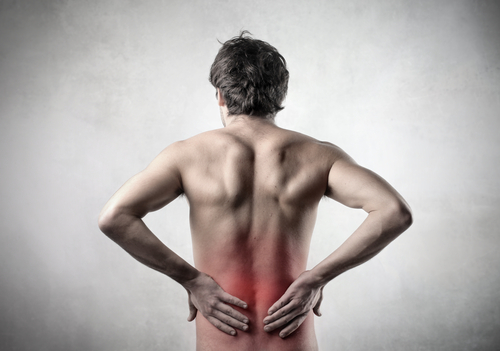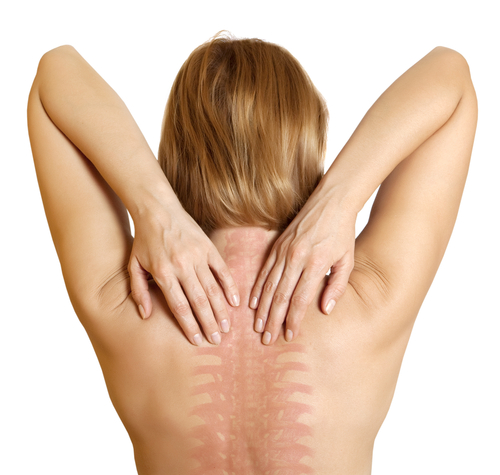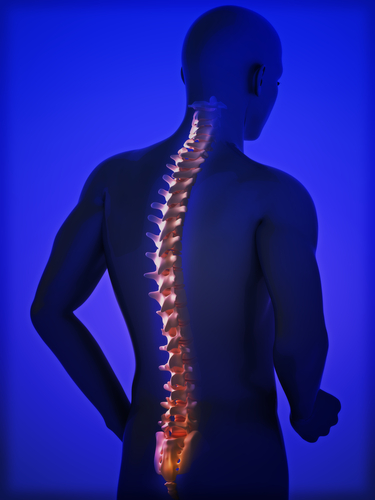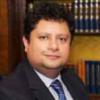This article discusses common forms of intractable pain that can be treated with modern neurosurgery techniques. This will be of help to anyone who is suffering from pain which is not controlled using pain killers.
Neurosurgery for Back Pain, Neck Pain, Brachialgia and Sciatica
- General principles of spinal treatments
- Minimally invasive spine surgery
- Back pain
- Neck pain
- Leg pain/sciatica
- Arm pain/brachialgia
- Lumbar/spinal stenosis
The first stage in the diagnostic pathway should be a thorough assessment by a neurosurgeon who will be able to identify which area of the spine is affected and which nerves may be involved. In most cases further tests will be ordered and this is usually an MRI scan of the spine. If a patient suffers from claustrophobia then it should be possible to arrange for the scan to be performed in an open MRI scanner which is more pleasant.
General principles of spinal treatments
A stepwise approach is used to treat most spinal disorders. This approach involves starting treatment with non-invasive and effective treatments such as physiotherapy and osteopathy. If this is ineffective then simple analgesics may help. Occasionally the doctor may use injections of steroid/local anaesthetic mixture which may alleviate back pain and sciatica. These injections may be to the epidural space (similar to a technique used in childbirth), facet joints or around individual nerves (perineural block).
Surgical treatments, although proven to be effective and safe, carry greater risks than non-operative treatments and are therefore only used in a minority of cases. There are many different operations used to treat back pain, neck pain and sciatica. Surgical treatments for nerve entrapment causing either sciatica or brachialgia are well studied and usually highly effective. Operations for back pain are generally more complex but may produce significant improvements in pain and quality of life.
Minimally invasive spine surgery
Over the last ten years spine surgery has evolved and many procedures are now performed using keyhole techniques. These techniques have resulted in much smaller cuts to the skin. Smaller incisions reduce the risk of infection and blood loss. They also reduce post-operative discomfort and usually reduce the length of hospital stay. One or two surgeons in the United Kingdom have pioneered the use of endoscopic discectomy. This is where a small camera and surgical instrument are introduced through a tiny incision and the disc and bone compressing the nerve removed. Not all patients are suitable for this form of surgery and currently it is only offered by a very small number of surgeons in the United Kingdom.
Back pain

Back pain is very common, affecting most people at some time in their life. In most people it is short lived but in some the pain can last for longer periods of time. Most patients are able to manage their pain with painkillers. Other treatments that may be helpful include manipulation therapy such as physiotherapy, osteopathy or chiropractic care. Acupuncture and TENS are sometimes useful. If these simple measures do not bring relief it is appropriate to consider surgical treatments. Your specialist will arrange an MRI to look for specific abnormalities which may be helped by surgery. If particular wear is seen within the facet joints then they may recommend an injection of steroid into the joints to help with your symptoms. If the discs appear to be the worn then they may recommend further investigations including discography to identify whether surgery such as spinal fusion may be of benefit.
Spinal Fusion
This operation is used to stabilise weakened areas of the spine in order to treat back or leg pain. Usually screws and rods are inserted to hold the vertebrae in position. Bone removed during the operation may be reinserted along with artificial bone in order to fuse the bones together. Sometimes the whole disc at the affected level is removed and small cages or spacers are inserted. Although most commonly used to treat conditions related to wear and tear (degenerative conditions) this procedure is also regularly used to treat fractures and tumours of the spine.
Various routes may be used to gain access to the affected area. Most commonly an incision is made in the middle of the lower back but sometimes an incision is made in the lower abdomen.
Spinal fusion surgery is most frequently used to treat loosening or slipping of the vertebrae; the medical name for this is spondylolisthesis. Fusing the spine in this setting has high success rates with 90% of patients noticing relief from their sciatic leg pains and over two thirds of patients noticing an improvement in their back pain. The most common risks of the procedure are infection or spinal fluid leakage. These complications occur in less than 5% of cases. Major complications such as nerve injury or paralysis are thankfully very rare occurring in between one in 200 and one in 1000 cases.
Spinal fusion is also used to treat back pain associated with degenerative disc disease. If you have chronic back pain which has not responded to non-operative treatments then your specialist may discuss this with you. If only a single disc is worn on your MRI scan then removing that disc and fusing the spine may help with the pain. If multiple discs are affected then a procedure called discography may be used to help identify which disc is responsible for the pain. Spinal fusion for back pain improves the symptoms in between 50 and 80% of patients.
Lumbar disc replacement surgery
If you have back pain and degenerative discs on your MRI scan then your specialist may recommend lumbar disc replacement. This procedure removes the disc and replaces it with an artificial one. This procedure may relieve the back pain but also preserve the normal movements of the spine and reduce the strain on the adjacent discs. The success rates of this procedure are similar to lumbar fusion with between 50 and 80% of patients noticing an improvement in their back pain. The risks of the procedure are similar to those of spinal fusion. This surgery can rarely produce alterations in sexual function and your specialist should discuss this with you before offering surgery.
Vertebroplasty
This technique is used to relieve the pain associated with spinal fractures or tumours. It is most commonly used to treat osteoporotic spinal fractures. The technique may be performed under local or general anaesthetic. Most patients go home the same day as the procedure.
To perform the technique a needle is passed into the affected bone using X-ray guidance. Once in position the broken bone is filled with cement to stabilise it and relive the associated pain. The procedure is safe and well studied, although there is a small risk of cement leaking into the bloodstream or spinal canal. If this occurs there is a risk of lung complications or paralysis.
Neck pain

Neck pain is very common and affects most adults at some point in their life. The neck is made up of multiple joints and these are frequently affected by wear and tear. An MRI scan may be used to identify areas of inflammation or arthritis within the neck. In most patients the pain will be short lived and can be managed with a short course of painkillers or manipulation by a physiotherapist, osteopath or chiropractor. If the pain is more prolonged then steroid or anaesthetic injections may help. Surgery is rarely used to treat neck pain alone although occasionally removal of worn discs in the neck can relieve the pain.
Leg pain/sciatica
Sciatica is pain, frequently felt in the buttock but spreading down the leg, due to a spinal nerve being compressed. Sciatica is very common affecting most adults at some time in their life. In most patients it is short lived and can be managed with simple painkillers but in some patients the pain is more severe and can be debilitating. In the more severe cases the spinal nerves may stop working normally and this can cause numbness in the leg, and in some cases, weakness of the affected muscles. In a small number of cases the important nerves to the bladder and genitalia may be compressed and this can cause difficulty passing water or numbness over the genitalia. This is considered an emergency condition as without surgery the urinary problems can become permanent. If you are suffering from back or leg pain and develop difficulty passing water or numbness over your genitalia or buttocks you should seek immediate medical attention the same day.
The usual investigation to diagnose disc disorders is an MRI scan of the spine. Disc herniations do not show up on x-rays although in some patients your specialist may recommend a CT scan. In many cases a small fragment of disc will be seen to be compressing a nerve which will explain the symptoms. Depending on the severity of the symptoms the specialist may recommend simple painkillers or physiotherapy. In more severe cases either a nerve injection or a small operative procedure may be recommended. The most common operation performed is a lumbar microdiscectomy.
Lumbar microdiscectomy
This is the most common operation performed to treat sciatica. Under general anaesthesia a small incision is made in the middle of the back. This is typically under an inch long. A small opening is made into the spinal canal and the piece of offending disc is removed. Not all of the disc is removed as most of the disc is still acting as a valuable “shock-absorber” within the spine. The operation typically takes less than one hour. Patients should be encouraged to walk around as soon as possible after the procedure and some are even well enough to go home on the evening of the procedure, although an overnight stay is more common. Patients usually report some moderate back discomfort for the first few days after the procedure. Depending on your occupation a period of between two and six weeks off work is usually recommended.
In terms of success rates, the operation is well studied and more than 90% of patients notice an immediate relief from leg pain on waking from the procedure. In around one in 20 patients a recurrence of the herniation may occur at some point in future life. All operations carry some degree of risk and this procedure is no exception. Minor skin infections occur in one in 200 cases and more major infections in around one in 400 cases. Occasionally the lining of the nerves may leak spinal fluid and this can prolong hospital stay, this occurs in around 1 in 200 cases. The risk of major complications such as paralysis of the legs or even death is of the order of between one in 1000 and one in 10,000 procedures.
Arm pain/brachialgia
Often the arthritic changes in the neck can cause pressure on the nerves of the spine. This can cause pain which spreads down the arm and may be associated with numbness or weakness in the arm. This pain may also be felt between the shoulder blades. If the arm pain is severe or not settling by itself then surgery may be performed to free up the compressed nerve. This surgery may be performed from the front of the neck (anterior cervical discectomy) or through the muscles at the back of the neck (posterior keyhole foraminotomy).
Anterior cervical discetomy and fusion/cervical disc replacement

This technique is performed though a small incision on the front of the neck, normally 4–5 cm long. Your surgeon will use a microscope to remove the disc and any areas of bone which may be compressing either the spinal nerves or the spinal cord. Once the disc has been removed either an artificial spacer or a disc replacement is inserted. There are advantages and disadvantages to both techniques.
Fusion using a disc spacer is a tried and tested technique that has been used for many years and has technical advantages if multiple discs need to be operated upon or a significant amount of bone needs to be removed to relieve pressure on the cervical nerves or spinal cord.
The main disadvantage is that all movement is lost at that level and while this is not usually noticed by the patient this loss of movement can put additional strain on the disc levels above and below accelerating degenerative changes at these levels. This phenomenon is known as adjacent segment disease and can result in surgery being required at these levels at a later date.
In theory, because a cervical disc replacement allows movement mimicking the normal function of the spine there is less chance of seeing ‘adjacent segment disease’. It is a newer technique however and not suitable for all patients (please see the section on anterior cervical discectomy and fusion).
Both techniques are very effective (>90%) at relieving the arm pain caused by a trapped nerve. The surgery does carry some small risks. The approach to the spinal column requires some pressure on the voice box and it is therefore normal for the voice to be hoarse for between a few days and weeks. Occasionally permanent changes to the speech can occur. Major complications such a paralysis or death can occur but are thankfully rare occurring in less than one in 400 cases. The aim should be to have you up and walking on the first day post-operatively and home within 3–5 days.
Posterior keyhole foraminotomy
This procedure uses a small incision (2–3cms) on the back of the neck to approach the affected nerve. Under a microscope and using a drill, a small area of bone compressing the nerve is removed. This procedure is over 90% effective at relieving arm pain. The risks of this technique are small and the risk of paralysis or weakness in the arm or legs is very small.
Lumbar/spinal stenosis
Many people develop a narrowing within the spinal canal as they get older, caused by arthritic changes. The medical terminology for this is spinal stenosis. The symptoms usually develop gradually over months and years. The most common symptoms are pain, and sometimes numbness or weakness, in both legs which worsens on walking and is relieved by rest. Sometimes problems with the blood flow in the legs can cause similar symptoms. A specialist should perform tests in order to confirm the diagnosis, usually an MRI scan. If your symptoms are mild it is reasonable to manage them with painkillers but if they worsen then an operation is the most effective treatment. The operations usually performed for this include a lumbar laminectomy, interlaminar decompression or an interspinous spacer. Some of them can be performed under local anaesthetic and do not usually require an overnight stay in hospital.
Lumbar laminectomy
This is the most common procedure performed for spinal stenosis. It is performed under general anaesthetic. The surgeon will make an incision in the middle of your back and use special instruments to remove the area of overgrown ligament and bone. It usually takes around one to two hours to complete. The operation is well studied and improves symptoms in around 80% of patients. There are small risks associated with the procedure. The risk of infection or spinal fluid leakage is around 1%. Major complications such as paralysis occur much less frequently in the order of between one in 1000 and one in 10,000 procedures. There is usually some discomfort in the back after the procedure but the aim should be to have the patient up and walking on the first day post-operatively and hopefully home within 3–5 days.









